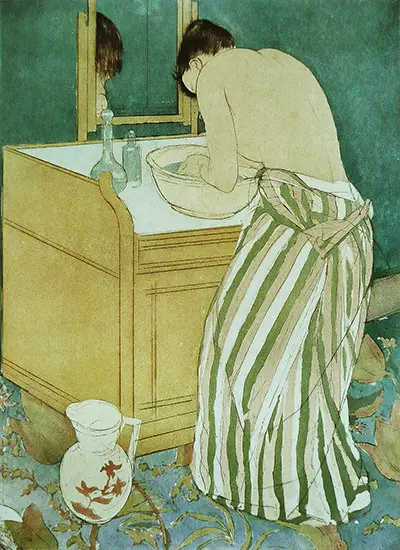 Buy Art Prints Now
Buy Art Prints Nowfrom Amazon
* As an Amazon Associate, and partner with Google Adsense and Ezoic, I earn from qualifying purchases.
Woman Bathing (La Toilette) is one of a series of print designed by Mary Cassatt towards the end of the 19th century. She would have required assistance in the printmaking process, as this was not a medium that she was particularly familiar with and there were several stages to producing the final artwork.
If we browse the design itself we find a female figure leaning over a basin of water, with her hands inside as she starts to wash herself. The mirror opposite provides a reflection that gives us an alternate view of her, which is a trick that Cassatt used several times within this series of prints. She wears a long dress or nightgown which is striped and also removed from the top half of her body in order to allow her to wash. The table on which she leans is fairly simple, without many decorative flourishes. There are a couple of items of perfumery next to the mirror and everything appears relatively functional. There are, however, some beautiful touches of detail around her feet, with a large jug that holds an Asian-style design which would have been used to carry water for the basin. The carpet below her is also patterned in a stylish way too. Each of these sets of colours would have represented a different stage in the printing process, with Cassatt initially leaving a clear set of boundary lines to lay out the design.
The ten different designs were initially exhibited together in 1891, having been produced at around that same time. She unveiled the items at the Galerie Durand-Ruel in Paris, the city in which most of her professional life was spent. Many were impressed by these drawings, particularly Edgar Degas, who would form a strong friendship with the female artist after becoming entirely convinced of her technical abilities. They would work together for the rest of this decade on and off, and shared a mutual respect for each other. She also knew other members of the Impressionist group personally, but not as well as Degas.
This print can be found in the collection of the Metropolitan Museum of Art in New York, USA. They own several parts of this same Japanese-inspired series of artworks which offers us an insight into the versatility of this artist. Cassatt would mainly concentrate on pastels and oil paintings within her career and enjoyed the vibrant colours that both mediums offered her, but she was still willing to try out other methods from time to time, particularly in the earlier parts of her career. The artist would also spend time in the company of other creative people who would inspire to try out some of the different techniques and styles that they themselves were already using. For example, her friendship with Degas would encourage her to work with pastels more frequently, having already perfected her skills with it earlier on. The Impressionists more generally were all about experimentation, and that trying out new ideas was all a part of their collective journey. Monet would also produce a large number of pastels himself, whilst Degas even tried his hand at sculpture on occasion.




